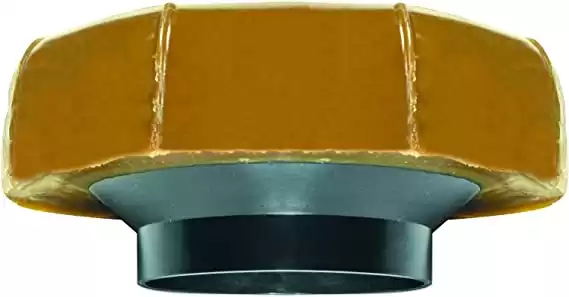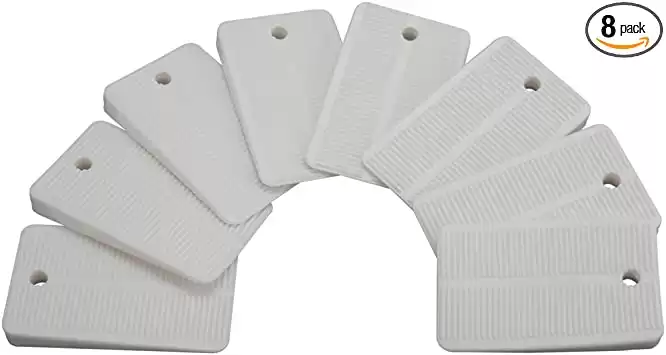If this toilet’s rocking, don’t come knocking! Wobbling toilets can be a home owner’s worst nightmare. And if they aren’t secured to the ground properly or you ignore them long enough, they can turn ugly!
A wobbly toilet can quickly turn into a leaky-wobbly toilet and cause damage not only to the flooring, but also to the subfloor, and the foundation of the entire room.
And, when it comes to the stability of your toilet, that’s an issue that you’re going to have to look into right away — before wobble turns to topple!
The Potential Damage Of A Wobbling Toilet
Aside from the uneasy feeling using a wobbling toilet can leave you with, this is an issue that can turn into something much larger. If left untouched, a wobbling toilet can lead to leaks that damage the walls, floors, and even the foundation of the entire room.
In other words, it’s an issue you need to have looked into and repaired ASAP or you could be looking at hundreds (or even thousands) in repair costs, depending on the type of flooring you have and how long you allow the problem to go unfixed.
What Causes a Wobbling Toilet?
There are many things that can make a toilet start to wobble. Generally speaking, it comes down to the toilet being improperly secured to the floor.
In other cases, the toilet could have corroded over time or something broke because it was too high. Your installer could even be to blame if they used a wax ring that was too thick.
More often than not, a wobbly toilet is just that: a wobbly toilet! As in, the issue is very likely caused by the toilet itself. However, on some occasions, the toilet might be just fine and it’s the floor underneath it that’s causing the stability issues.
If it turns out to be the latter, that means you’ve got an unstable subfloor. Which has likely been damaged by the leaking toilet base. In this situation, the subfloor is soft and it could give at any moment. So you better stop using the bathroom in question until you have a professional come out to take a look.
Hopefully, they’ll be able to tell you what has damaged the subfloor (water damage, termites in the foundation, etc.) and what it will take to fix it before things start falling in.
If you’re able to rule out any issues with the surrounding subfloor, then you should be okay to start looking for DIY solutions on your own.
How To Fix Your Wobbling Toilet
Here’s the step-by-step process to make your toilet stable again!
Tools And Materials Needed
- Plastic shims
- Utility knife
- Adjustable wrench or Smooth-jaw pliers
- Tub and tile caulking (color-matched to your toilet and flooring)
- Caulking gun
- Tooling foam
- Silicone finishing tool
- Paper towels or a rag
- Knee pads or a
towel to kneel on
The perfect bead caulking finisher!
The scratch-free rubber head forces caulk into joints creating a smooth bead of caulking every time.
1. Check For Leaks
Before you do anything, including adding a shim, you should always be wary of potential leaks. Inspect your toilet carefully. Look around the base of the toilet and check if there is water present.
If you find leaks, that means the wax ring that seals the toilet to the flange is now old and fragile. It has been compressed or deformed over time. This means you must immediately remove your toilet to swap out the old ring for a new wax ring.
No leaks with extra thick protection!
Confidently seal your toilet with 40% more wax than standard wax seals. And it comes with an extended flange that will seal to 3" or 4" waste lines.
You might also need to have a professional check for further water damage and remedy any water damage that has occurred.
No leaks? Continue to step two!
2. Collect Your Tools
If there are no leaks present, you’ll need a utility knife, tub/tile caulk that matches your toilet,
When it comes to the
Opt For Soft Shims
Soft plastic
White soft plastic toilet shims that are perfect for levelling or fixing a wobbling toilet bowl.
3. Tighten The Bolts
A simple cause for a loose toilet is loose bolts. You’ll want to tighten these bolts carefully as tightening too much can crack the porcelain base of your toilet, causing permanent damage.
Using smooth jaw pliers or an adjustable wrench, check the flange bolts on either side of the toilet and ensure they are equally tight. They should be just snug, then test the toilet for stability.
Do the bolts look good? Move on for other potential fixes.
4. Check The Flange
Beneath the toilet is the main flange, which connects the toilet to the drain pipe. Sometimes this flange is placed on a little pedestal, which makes it a little above the surrounding floor. That means the toilet sits higher in the center, leading to a loose fit and, therefore: wobble.
This issue won’t be noticed right away, but will instead develop after the toilet has been sitting for a while, the caulk hardens, and the surrounding floor settles a bit.
Easily fixes leaking toilets by repairing a damaged or broken closet flange.
Installed together with a new wax ring to create a perfect seal!
5. Look For Gaps
Inspect the base of the toilet and check for gaps that might be visible between the toilet base and the floor. This could be the main cause of the wobble, and it can be easily fixed by shimming in the gaps.
If you find gaps, insert your plastic or rubber
Using a utility knife, you can trim the sides of the
6. Caulk Around The Base
Once you have put shimmed your toilet and you’re happy with how it sits, get out your caulk and apply a very thin layer all the way around the toilet. You should cover the gaps completely so that you cannot see space between the bowl and the flooring or the
You can use your finger or a silicone tool to clean off excess caulk so you get a very clean line. The caulk is crucial to keeping your toilet clean. So make sure you seal it up so any water gets trapped outside the base and not under it!
Keep The Back Uncaulked
We recommend not to
7. Let The Caulk Dry
Read the directions on the tube of caulk you bought so that you know just how long it needs to dry. Don’t let moisture get into the caulk or general area until it’s fully dried and cured.
When To Call The Pros
Fixing a rocking or wobbling toilet can be an easy DIY task to tackle but there are a few instances when it’s best left to the professionals.
If you see any signs of water damage, call in an expert immediately. Leaving it unfixed will only weaken your subfloor, which can cause major flooring damage and even foundation issues. Weak and softened wood can also attract termites, yikes!
If shimming and tightening the bolts doesn’t work and your toilet continues to wobble, you might need to remove the toilet and check the metal/plastic rings that hold the flange bolts together as they can ultimately corrode and break. If this is too much for you to confidently handle, seek the help of a plumber to finish the job.
Everyone wants to avoid a call to the plumber, but they’re ultimately the best person to reach out to if you’re having trouble with a wobbling toilet that you can’t seem to fix on your own.
Conclusion
Save the rocking for the concert, not the bathroom. A wobbling toilet can be stabilized in just a few minutes. Just don’t procrastinate and put off this plumbing project. Rock on… or not!
Happy Plumbing!
Recommended Reading
How To Fix Annoying Clogged Shower Drains
Using a clogged shower is disgusting, you are standing in a puddle of your own dirt, yuk! We will show you 10 DIY ways to unclog your shower drain!
Everything You Need To Know When Buying A New Toilet
Did you know that the average person spends nearly a whole year on a toilet over their lifetime? Let us help pick the perfect new toilet for you!
Plumbing Services: What’s This Going To Cost Me?
The one question you ask before you hire a plumber is, how much is this going to cost? Learn the types of plumbing services and how they affect your wallet.
How To Fix A Leaking Hose Bib
Don't let a leaky hose bib ruin your summer. We will show you how to fix your outdoor faucets so you can get back to having fun in the sun!
How To Snake A Toilet
Conquer that clogged commode with a toilet auger! We will show you how to properly snake a toilet and bust up that blockage!
How To Stop Your Water Heater From Making Scary Noises
Find out how to silence your water heater once and for all with our guide. Learn how to quite your water heater noises all by yourself!



